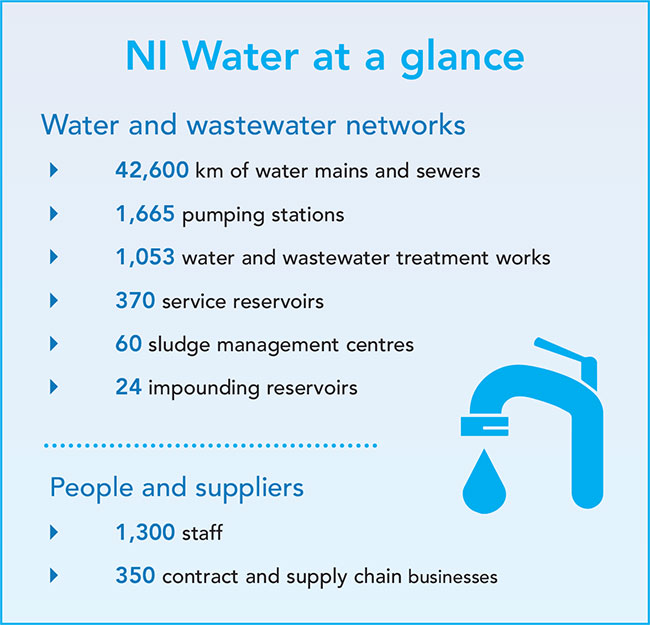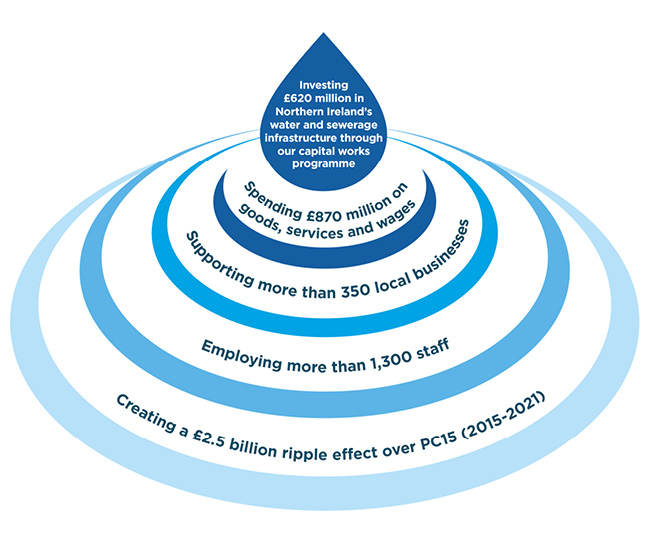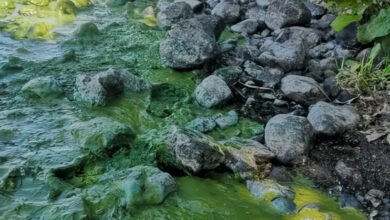Pumping millions, creating £billions

Every day, every aspect of business and domestic life in Northern Ireland depends on the services NI Water provides. Supplying millions of litres of clean fresh drinking water and safely managing wastewater and sewage is vital for our economy, for people’s health and for protecting the local environment.
NI Water manages and maintains one of the largest infrastructure networks in Northern Ireland. It supplies an average of 570 million litres of clean drinking water every day to 850,000 households and business through 26,800 km of water mains and collects an average of 340 million litres of wastewater every day from 680,000 households and businesses through 15,800 km of sewers.
With a total network of over 42,000 km it is one of Northern Ireland’s longest infrastructure networks; NIE has just over 49,000 km of transmission and distribution network1, there are circa 26,000 km of roads2 and the natural gas networks total circa 6,000 km3.
But it’s not just pipes in the ground,
NI Water also manages and maintains thousands of above ground assets needed to collect, treat and pump water and waste water: 1,665 pumping stations, 1,053 water and wastewater treatment works, 370 service reservoirs, 60 sludge management centres and 24 impounding reservoirs.
Vital infrastructure
Chief Executive Sara Venning explains: “Water and wastewater is probably the most vital of all the utilities needed for business, at the very least it’s equally as important as power, roads and communications. For a business to operate it needs both water and wastewater, whether that is just for its staff or as part of its production processes or service offering where significant volumes of both are often required. So, it is vital that businesses can not only make a physical connection to the water and wastewater networks but also that both networks have the capacity to safely manage their water and waste water volume requirements”.
Venning continues: “Our focus going forward has to be on building resilience and capacity. A significant portion of
NI Water’s infrastructure assets were originally constructed decades, even centuries ago and both networks and above ground assets have suffered from a history of under investment. Analysis of legacy records from the 79 local authorities that had responsibility for the networks pre 1973, and more recent records from the former DOE and DRD, shows that currently over 70 per cent of water and sewer mains are more than 50-years-old and constructed from over 20 different material types of pipe.”
Has NI Water performed since its formation just 10 years ago in 2007?
NI Water was formed as a GoCo following separation from central government in 2007 and since forming the focus has been to continually drive efficiencies. As any business will recognise, removing cost and complexity is key and in just 10 years NI Water has taken over £65 million off its costs has been able to reduce staff levels from over 2,500 to around 1,300.
Venning explains: “Our results are there for all to see. NI Water, from virtually a standing start 10 years ago, has closed the efficiency gap between us and our peers at a rate not equalled by any other water utility on these islands. We now find ourselves closing in on the best in class and we are determined not to slacken the pace as we move forward.
“Our strategy focuses on customer promises, derived from working collaboratively with our stakeholders, to deliver the best possible levels of service within the funding available through the Price Control (PC) period. 2016/17 was another strong year of performance despite uncertainty over the funding for PC15 (2015 to 2021). We outperformed the target for our overall level of customer service, our level of wastewater compliance was at a record level of 98.89 per cent and water compliance at a near record level of 99.86 per cent. We met our supply interruption and sewer flooding targets and pollution incidents continue to be at near record low levels.”
She continues: “Our strong performance and focus on reducing running costs meant that the average increase in non-domestic tariffs of 1.65 per cent for 2017/18 was both less than inflation and that permissible by the Utility Regulator, meaning that business customers will pay 12 per cent less in real terms for their water and sewerage services than they did in 2012/13.”
“Our investment is both vital and significant in underpinning economic growth.”
NI Water’s £2.5 billion ‘ripple effect’ on Northern Ireland’s economy
Mark Bailey, an economist from Ulster University Business School, analysed NI Water’s 2016/17 expenditure in order to estimate the full ‘ripple effect’ to the economy of NI Water’s activities over the PC15 period (2015-21).
Venning explains: “Every day we supply 570 million litres of clean water as well as treating 340 million litres of wastewater. Our investment in our capital works programme, our staff costs and our expenditure on goods and services pumps millions of pounds into the local economy. The ripples from our investment don’t just reach our own employees and suppliers, they are felt by a wide range of other businesses from agri-food production, to new house construction, to tourism development”.
She continues: “Ulster University Business School estimate that for every £1 invested by NI Water, the knock-on effect in the local economy is almost double. In purely economic terms then, our £2.5 billion ‘ripple effect’ over the six-year PC15 period (2015-2021) can be viewed as a major contributor to Northern Ireland’s GVA”.
1 http://www.nienetworks.co.uk/About-us
2 https://www.infrastructure-ni.gov.uk/…/northern-ireland-transport-statistics-2014-2015
3. https://www.uregni.gov.uk/gas








